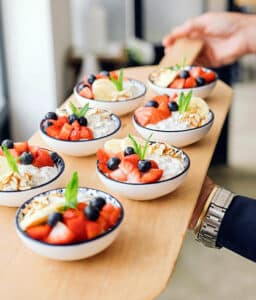Clean eating
What is clean eating?
Clean eating is very popular in the United States and some other developed countries, but what it really means is not entirely clear, since it is defined differently in different sources.
In other words, the answer to the question: “What is clean eating?” will depend on to who you ask this question.
The following are mentioned as the origins of clean eating:
- 2007 when Canadian fitness model Tosca Reno published the book “The Eat-Clean Diet“;
- 2009 when Alejandro Giunger, a former cardiologist from Uruguay, published the book “Clean: The Revolutionary Program to Restore the Body’s Natural Ability to Heal Itself“;
- 2013 – 2014 when blogger Jordan Younger began to promote her all-raw, plant-based diet “Five-day “cleanse” program”. Although Jordan Younger did not have any education related to nutrition science, the popularity of the diet was huge – in the spring of 2014, about 40,000 copies had already been sold. Ironically, this diet almost killed its author.
At the moment, there is still no clear definition of what clean eating is.
To understand what people mean by the term “clean eating”, IFIC conducted a survey in 2021, during which it was found that:
- Almost half of the respondents consider themselves “clean” eaters;
- In response to the question of what this means, 21% answered – eating food that is not highly processed, 14% – eating foods found in the fresh products section; 13% – eating organic foods, 11% – eating food with a simple ingredient list and 9% defined it as eating foods made with ingredients I consider to be “clean”;
- 63% of respondents said they try to choose food made from “clean” ingredients;
- On the other hand, when answering the question: “how would you define “clean” ingredients”, 22% answered – Not artificial or synthetic, 16% – described as organic, 15% – described as fresh, 14% – Something I know is nutritious, 14% – described as natural, 6% – does not have a chemical sound name, 6% – has a name I can pronounce, 6% – has a familiar or recognizable name;
As you can see, opinions vary greatly.
To summarize – it is usually assumed that clean eating refers to food that is as close as possible to its natural state, natural and with a minimum amount of chemical additives and preservatives. Clean eating can include whole fruits, vegetables, lean proteins, whole grains, and healthy fats, but ultra-processed foods and packaged foods with added sugar and salt should be limited.
Just as there are different levels of vegetarianism, such as veganism, lacto-vegetarianism, and lacto-ovo-vegetarianism, a person who “eats cleanly” may have different ideas about what foods are “clean” and what is “dirty” – some refuse foods that have been treated with hormones, antibiotics, and pesticides, while others do not eat packaged foods, etc.
The dark side of clean eating
As in most cases, problems are caused by exaggerations and unrealistic expectations.
If by clean eating we mean that:
- More raw or minimally processed foods should be consumed in the diet;
- It is necessary to avoid ultra-processed foods (which contain preservatives, flavor additives, emulsifiers, etc., and also promote overeating and emotional eating);
- It is necessary to cook more on your own and have meals with family and friends.
Then clean eating is much like what we mean by a healthy diet.
But.
If we start dividing food into “Clean” and “Dirty” and in order not to become “Dirty” ourselves, we exclude whole food groups from our menu, such as dairy products, whole grains, etc.
Then.
Our menu is getting too restrictive. In other words, the risks of deficiency of various nutrients increase significantly, which, in turn, can lead to serious health problems, worsen well-being and destroy our beauty (problems with skin, hair, and nails).
Lack of clarity (what exactly is clean eating) and a tendency to divide foods into “good” (clean) and “bad” (dirty) can lead to an unhealthy obsession with “healthy” foods – a disease called orthorexia.
What is Orthorexia?
Orthorexia Nervosa is a term coined in 1997 by Dr. Steven Bratman. Currently, there is no universal definition of Orthorexia Nervosa and diagnostic criteria, since it is a relatively recently identified eating disorder, and it is often difficult to distinguish it from ordinary health care.
Orthorexia Nervosa is a condition in which a person takes extreme care of a healthy diet, with the aim of achieving complete “cleanliness” of the diet – it is an obsession with a “healthy” diet that causes suffering, anxiety, or obsessive-compulsive disorders.
Just as anorexia nervosa is aimed at weight loss (limiting the amount of food), orthorexia Nervosa is aimed at healthy eating (limiting certain types of foods).
Some researchers believe that orthorexia Nervosa is the extreme option of clean eating.
The main signs are as follows:
- Pathological passion for a healthy diet;
- Emotional problems (for example, discomfort, anxiety) in case of non-compliance with self-established dietary rules;
- Psychosocial disorders, as well as malnutrition and weight loss.
At first, it may seem that Orthorexia Nervosa is not dangerous, because a person does take care of his health and tries to eat healthily, however, in practice, this usually means excluding whole groups of food products from his menu and, therefore, an unbalanced diet and nutrient deficiency.
Myths about clean eating
In this case, the most common claims of clean eating promoters.
Eating clean is always good
The fact that a person (in his own opinion) eats “cleanly” does not mean that he eats in a balanced way and provides his body with everything it needs, especially if eating “cleanly” excludes whole groups of “unclean” food products.
In addition, communication problems and emotional discomfort may also occur:
- By eating “clean”, people may begin to isolate themselves from others because they are too focused on their diet and are afraid of criticism from colleagues, friends, etc., who do not follow the same diet;
- Feelings of guilt/self-flagellation may arise if they cannot fully comply with the “clean” diet they themselves have established.
Some foods are “dirty”
Many proponents of “clean” nutrition believe that all foods containing additives are “dirty” because they are not in their purest and most natural state.
However, the fact that there are additives in food does not mean that they are harmful to health.
There are neutral and also beneficial food additives, such as:
- vitamin D, which is necessary to strengthen bones and whose levels are too low for those living in the Nordic countries for most of the year;
- Iron, which the body needs for the production of hemoglobin, for the growth and development of the body.
Chemical names of additives sometimes also create a misleading impression, for example – NaCl, which means sodium chloride, or ordinary table salt (necessary for regulating the amount of fluid, as well as nervous and muscular activity).
Too much salt is harmful to health and causes water retention, but it is also true that we cannot exist without salt.
Clean eating is healthy eating
If you avoid only ultra-processed foods, try to eat healthily, and try to understand what the foods you eat give your body – you are really moving towards healthy and conscious eating.
However, clean eating is not the same as a healthy diet, since the recommendations of a healthy diet do not exclude processed, pre-prepared, or packaged foods, such as:
- Healthy oils such as unrefined olive and sunflower oils;
- Wholemeal bread, pasta, and brown rice;
- Dairy products;
- Fruit and vegetable juices;
- Ect.
In short, a healthy diet doesn’t have to be as restrictive as clean eating. This does not mean that adherents of clean eating are doing something bad for their health. However, it is important not to overdo it and maintain a healthy attitude to food.
And – we can eat healthy without calling it clean eating or otherwise 😊.
Key takeaways
A healthy diet and lifestyle are more important today than ever, as they can significantly reduce the risks of chronic diseases.
An unhealthy diet shortens life more than smoking!
That is why you should not follow all kinds of fad diets and recommendations on social networks, especially if they are expressed by people who do not have adequate education and experience. Jordan Younger, with her “Five-day “cleanse” program”, is a good example of this.
The concept of clean eating, if it means eating more vegetables and fewer ultra-processed products, eating a variety, and cooking more on your own – is a good start.
Eat delicious, and varied, and be healthy!
Sources:
IFIC Survey: From “Chemical-sounding” to “Clean”: Consumer Perspectives on Food Ingredients
Clean eating and the cult of healthism
Eating clean and green? Investigating consumer motivations towards the purchase of organic food
Definition and diagnostic criteria for orthorexia nervosa
Healthy Food on Instagram Social Network: Vegan, Homemade and Clean Eating

Help to maintain this site, create interesting articles and delicious low-calorie recipes!
Share this article
Follow me on Facebook
I recommend reading these articles as well

Deep muscles - what is it and why should it be trained?
Deep muscles are not visible - however, they are important for maintaining health and especially back health.

How to exercise and keep fit at home
If you do not have the opportunity or the commitment to go to the gym - do it at home.

Pulse zones
How to find out how effective your workouts are? For example, when you run, you burn fat, develop endurance, or speed, or maybe strength? Is your physical activity intense enough, insufficient or, on the contrary, too intense?

Superfoods
What are superfoods? What are superfoods good for? What do they do, and how are they good for our health and well-being?

